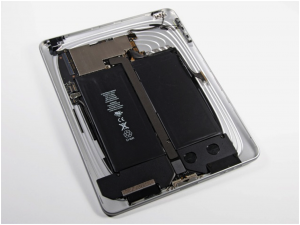
Let’s add it all up – the electronics pilots take with them on a long cross country trip. We have two iPads (one for the pilot and one for the co-pilot), two cell phones, an ADS-B receiver or external GPS for those iPads and maybe a smartwatch or two. Most of these items would be on pilot’s required materials list for flight.
If you’re using the iPad as the main source of aviation charts, you definitely don’t want the battery running out of juice before touchdown. As a rule of thumb, the battery will last about 4 to 6 hours on a full charge when using it as a GPS navigator.
An external battery pack can be a lifesaver in today’s modern cockpit. Let’s dig into the details of the devices you carry and these backup batteries to expose what you need to look for and what to avoid.
iPad battery specs
First off you have to know the needs of your devices. iPads require more power to function than a tiny external GPS. iPhones need less input to charge than your ADS-B receiver in most cases. The chart below is your quick reference guide to the real specs of your batteries.
iPad Mini 1-4: Battery size 4,500 – 6,400 mAh
The original iPad 1-4: Battery size 6,600 – 11,500 mAh
iPad Air 1-2: Battery size 7,300 – 8,800 mAh
iPad Pro 9.7”: Battery size 7,300 mAh
iPad Pro 12.9”: Battery size 10,300 mAh
As a general rule of thumb, mobile phones and the iPad Mini only require 1 amp to charge. The full size iPads and iPad Pro require 2.1 to 2.4 amps. The larger phones, often referred to as “phablets”, may also need 2 amps or more and vary by device.
Your Stratus 2S ADS-B receiver should also be charged with a 2 amp charger for the best rate. In a pinch though you can charge any of these devices with a 1 amp charger, though you’ll experience a slower charging rate. The reverse is true too –you can charge a 1 amp device (like an iPhone) with a charger rated at 2 amps. Don’t worry, it won’t cause any harm. Let’s take a closer look at why all this matters.
Not all power sources are created equal
When charging your iPad, no matter which model you have, make sure you have a minimum 2 amp output USB port. Less than 2 amp is insufficient for fast charging and depending on the device may not charge at all. USB hubs for charging are typically 1 amp to 2.4 amps. It’s simple–the higher the amp output of the hub the faster the device plugged into that hub will charge.
When you’re buying a backup battery for the plane consider two things- how many mAh the battery is and the amps output the USB ports charge at. Based on the numbers above you can get an idea of the capacity your iPad has and make sure you’re buying a large enough backup battery for your needs.
The Professional Power iPad/iPhone Battery has 20,800 mAh of battery and offers 4 USB ports as seen below. Two of the ports provide 2.4 amp output, while the other 2 deliver 1 amp for mobile phones. This battery is a big one–20,800 mAh is enough juice to recharge your iPads, Stratus, and cell phones multiple times.
The Rugged Portable Battery Pack has two 2.4 amp USB ports and 12,000 mAh of battery. Quick charge features are built into the battery. As an added bonus the battery is waterproof when stored with the hatch door closed.
The Dual 2.4 USB Cigarette Lighter Charger is exactly how it sounds. Two 2.4 amp USB charging ports and plugs into a cigarette lighter on the panel of your aircraft. The charger is compatible with 12V and 28V systems.
Operating temperatures are key
Charging your device when it’s inside certain styles of cases may generate excess heat, which can affect battery capacity. If you notice that your device gets hot when you charge it, take it out of its case first. Your device is designed to perform well in a wide range of ambient temperatures, but consider 62° to 72° F (16° to 22° C) to be the ideal comfort zone.
It’s especially important to avoid exposing your device to ambient temperatures higher than 95° F (35° C), which can permanently damage battery capacity. That is, your battery won’t power your device as long on a given charge. This means that leaving your iPad in a hot plane while you’re eating lunch is a bad idea. Storing a battery in a hot environment for an extended period of time can cause irreversible damage.
When using your device in a very cold environment, you may notice a decrease in battery life, but this condition is temporary. Once the battery’s temperature returns to its normal operating range, its performance will return to normal as well.
Dim the Screen to extend battery life
There are two simple ways you can extend battery life, no matter how you use your device: lower your screen brightness and disable unneeded wireless radios. Cellular service, WiFi and Bluetooth require extra power, and should be turned off when not needed in flight.
The other big power draw is the screen’s backlight. Consider dimming the screen or turn on Auto-Brightness to extend battery life:
- To dim, swipe up from the bottom of any screen to open Control Center and drag the Brightness slider to the left.
- Auto-Brightness adjusts your screen to lighting conditions automatically. To activate it, go to Settings > Display & Brightness and set Auto-Brightness to On.
Check out these articles for more information:
iPad Battery Test: What really matters?
How to maximize battery life – tips for better performance
Source: Ipad appsKeeping your charge–iPad battery tips







